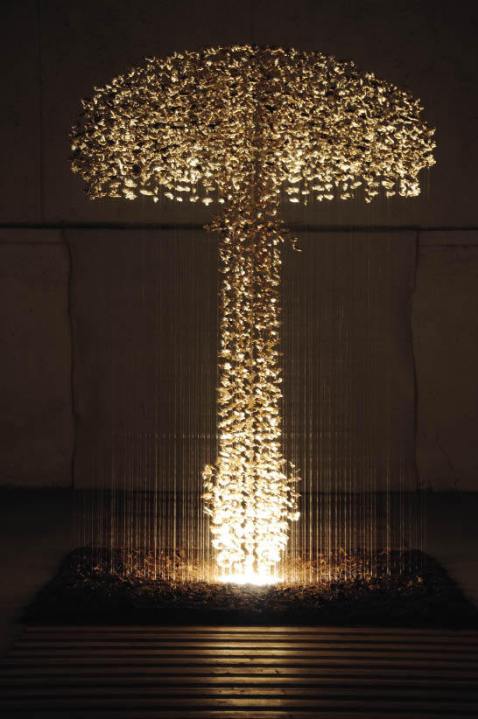The park was founded nearly 25 years ago by a trio of friends from Borgo Valsugana, a small town near Trento in the Italian Alps: Carlotta Strobele, a philosophy graduate whose Viennese family’s connections with the area go back to when the region formed part of the Austro–Hungarian Empire; Emanuele Montibeller, a former market trader in fabrics and a local councillor; and Enrico Ferrari, an architect — all of whom shared a passion for contemporary art. It now covers a wide area in Val di Sella, a secluded valley of forest, glades and rolling meadows, high above Borgo, at the end of a narrow road that zigzags its way up precipitous and densely wooded slopes, beneath a chain of peaks over 6,000-feet high.
In 1986 a dozen artists from various countries were asked to Carlotta Strobele’s summer house in Val di Sella and invited to create an artwork. Since then more than 200 artists from all over Europe and countries as distant as Azerbaijan, South Africa, Israel, the US, Australia, New Zealand, South Korea and Japan have constructed site-specific sculptures, reached by a series of winding ‘art-nature’ paths.
Most of the works are made of locally found materials — wood, vegetation, stone — but the results are rich and varied. Many of the installations are highly imaginative and inventively realised. Not a few of them have a simplicity and beauty that harmonises perfectly with the mountainous surroundings. But exposed to the elements all, or nearly all, have quite limited lifespans. ‘The works come out of the landscape, they inhabit it and, according to nature’s timescales, they return to it again,’ as the founders have described the park’s philosophy.
Giuliano Mauri’s enormous ‘Cattedrale Vegetale’ has been an organic work-in-progress since 2001. It consists of 80 12-metre-high timber tree-frame columns, each planted with a hornbeam sapling, which grows about half a metre a year, the overarching top branches curving towards one another to create three Gothic naves 82 metres long, covering more than 1,200 square-metres of meadow. The ‘Cathedral’ has become Arte Sella’s most famous feature, but nature will eventually be allowed to take its course and the work will one day be absorbed into the surrounding forest.
Anton Schaller, a German artist and master joiner, is inspired by religions of both East and West in his luminous gold-hued bell-shaped Buddhist stupa. It is actually made of thousands of blocks of pinewood, and belfry-like contains a bell that can be rung by pulling on an iron ring.
The American Steven Siegel’s ‘Bridge II’, which spans a stream, is both a thoroughfare and a ‘tour de force’ of trompe-l’oeil architecture. Its parapets mossy and leaf-covered, it has the appearance of a venerable old dry-stone bridge. On very close examination it turns out to be built of artfully stacked newspapers, using an engineering technique that goes back to the ancient Romans.
The imaginative and adventurous English land artist Chris Drury was invited to build a work here in 1994, which has long disappeared back into the woods. A graduate of Camberwell College of Art in London, Drury, now in his early sixties, has ploughed a somewhat solitary but highly productive furrow. His projects have involved working with a wide range of professionals, including scientists, medics and conservationists. Although not entirely a prophet without honour in his own country — he has works dotted all over the British Isles — his thoughtful disposition, technical skills and particular aesthetic sensibility have perhaps been more fully valued further afield (and Arte Sella has consistently demonstrated a flair for international talent-spotting).
Since 1990 Drury has been experimenting with ‘Cloud Chambers’, buildings in which apertures in the roof or wall create a ‘camera obscura’, bringing, as Drury says, ‘what is on the outside, inside’. He has built a number of them in various parts of the world and with local assistance Drury spent a month this summer constructing ‘Sky Mountain Chamber’ in Val di Sella. This corbelled beehive dome has a south-facing aperture that throws a dream-like image of the forest, towering mountain peaks, sky and passing clouds outside into the whitewashed interior.
This latest ‘Cloud Chamber’ might be viewed with some alarm by Arte Sella’s organisers, given that structures of this kind can last for centuries — although, as Drury admitted when I met him there, it could yet subside (it weighs about 150 tonnes) or be demolished by a falling tree.
The English artist has also long been fascinated by the artistic and symbolic possibilities of fungi. ‘A mushroom’, as he puts it, ‘can feed you, kill you or cure you.’
He was just completing ‘Mushroom Cloud’, a second work commissioned by Arte Sella this year, this time for its temporary exhibition space in an old milking parlour at Malga Costa, a one-time farm that since 1998 has been Arte Sella’s headquarters in the valley. A more reliably ephemeral work, composed of about 3,000 dried mushrooms suspended on fishing-line and upward lit from beneath the floor, this dazzling thermonuclear detonation in a darkened cowshed is a spectacle both strangely beautiful and subtly disconcerting.







Comments